Continuous-Variable Quantum Key Distribution Robust Against Polarization-Dependent Loss
Abstract
1. Introduction
2. The PDM-Based CVQKD Scheme
3. The PDL-Involved CVQKD System
3.1. Polarization-Dependent Loss in Communication
3.2. The Effect of PDL on Orthogonal Components
3.3. The PDL-Involved CVQKD System
4. Polarization-Pairwise Coding Scheme
5. Performance Analysis
6. Conclusions
Author Contributions
Funding
Conflicts of Interest
Appendix A. The Calculation of BER
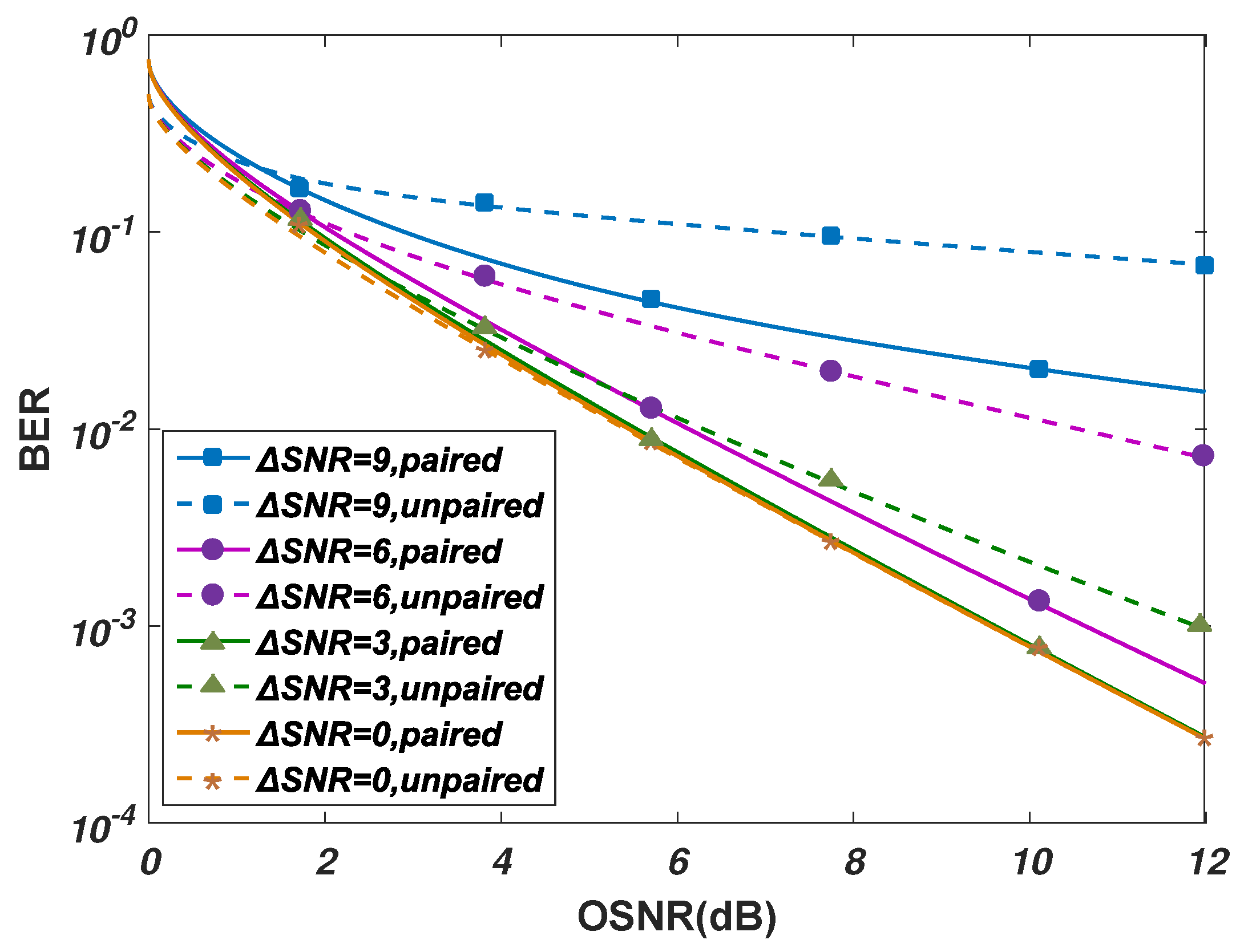
Appendix B. The Calculation of SNR
References
- Lo, H.K.; Curty, M.; Tamaki, K. Secure quantum key distribution. Nat. Photon. 2015, 8, 595–604. [Google Scholar] [CrossRef]
- Weedbrook, C.; Pirandola, S.; García-Patrón, R.; Cerf, N.J.; Ralph, T.C.; Shapiro, J.H.; Lloyd, S. Gaussian quantum information. Rev. Mod. Phys. 2012, 84, 621–669. [Google Scholar] [CrossRef]
- Ralph, T.C. Security of Continuous Variable Quantum Cryptography. Phys. Rev. A 2000, 62, 103031–103034. [Google Scholar] [CrossRef]
- Samuel, L.B.; Peter, V.L. Quantum information with continuous variables. Rev. Mod. Phys. 2004, 77, 513. [Google Scholar]
- Grosshans, F.; Grangier, P. Continuous variable quantum cryptography using coherent states. Phys. Rev. Lett. 2002, 88, 057902. [Google Scholar] [CrossRef]
- Grosshans, F.; Assche, G.V.; Wenger, J.; Brouri, R.; Cerf, N.J.; Grangier, P. Quantum key distribution using Gaussian-modulated coherent states. Nature 2003, 421, 238–241. [Google Scholar] [CrossRef] [PubMed]
- Huang, D.; Huang, P.; Huang, P.; Zeng, G.H. Long-distance continuous-variable quantum key distribution by controlling excess noise. Sci. Rep. 2016, 6, 19201. [Google Scholar] [CrossRef]
- Huang, D.; Huang, P.; Lin, D.; Wang, C.; Zeng, G.H. High-speed continuous-variable quantum key distribution without sending a local oscillator. Opt. Lett. 2015, 40, 695–3698. [Google Scholar] [CrossRef]
- Xu, B.; Zeng, B. Improving the maximum transmission distance of four-state continuous-variable quantum key distribution by using a noiseless linear amplifier. Phys. Rev. A 2013, 87, 062311. [Google Scholar] [CrossRef]
- Qu, Z.; Djordjevic, I.B.; Neifeld, M.A. RF-subcarrier-assisted four-state continuous-variable QKD based on coherent detection. Opt. Lett. 2016, 41, 5507. [Google Scholar] [CrossRef]
- Guo, Y.; Liao, Q.; Wang, Y.; Huang, D.; Huang, P.; Zeng, G.H. Performance improvement of continuous-variable quantum key distribution with an entangled source in the middle via photon subtraction. Phys. Rev. A 2017, 95, 032304. [Google Scholar] [CrossRef]
- Guo, Y.; Li, R.J.; Liao, Q.; Zhou, J.; Huang, D. Performance improvement of eight-state continuous-variable quantum key distribution with an optical amplifier. Phys. Lett. A 2018, 382, 372–381. [Google Scholar] [CrossRef]
- Huang, P.; Huang, J.Z.; Zhang, Z.S.; Zeng, G.H. Quantum key distribution using basis encoding of gaussian-modulated coherent states. Phys. Rev. A 2018, 97, 042311. [Google Scholar] [CrossRef]
- Huang, D.; Lin, D.; Wang, C.; Liu, W.; Fang, S.; Peng, J.; Huang, P.; Zeng, G.H. Continuous-variable quantum key distribution with 1 Mbps secure key rate. Opt. Express 2015, 23, 17511–17519. [Google Scholar] [CrossRef] [PubMed]
- Huang, D.; Huang, P.; Li, H.; Wang, T.; Zhou, Y.; Zeng, G.H. Field demonstration of a continuous-variable quantum key distribution network. Opt. Lett. 2016, 41, 3511–3514. [Google Scholar] [CrossRef]
- Lodewyck, J.; Bloch, M.; García-Patrón, R.; Fossier, S.; Karpov, E.; Diamanti, E.; Debuisschert, T.; Cerf, N.J.; Tualle-Brouri, R.; McLaughlin, S.W.; et al. Quantum key distribution over 25 km with an all-fiber continuous-variable system. Phys. Rev. A 2007, 76, 538. [Google Scholar] [CrossRef]
- Chi, Y.M.; Qi, B.; Zhu, W.; Qian, L.; Lo, H.K.; Youn, S.H.; Lvovsky, A.I.; Tian, L. A balanced homodyne detector for high-rate Gaussian-modulated coherent-state quantum key distribution. New J. Phys. 2011, 13, 87–92. [Google Scholar] [CrossRef]
- Qu, Z.; Djordjevic, I.B. High-speed free-space optical continuous-variable quantum key distribution enabled by three-dimensional multiplexing. Opt. Express 2017, 25, 7919. [Google Scholar] [CrossRef]
- Winzer, P.J. High-Spectral-Efficiency Optical Modulation Formats. J. Lightwave Technol. 2012, 30, 3824–3835. [Google Scholar] [CrossRef]
- Lichtman, E. Limitations imposed by polarization-dependent gain and loss on all-optical ultralong communication systems. J. Lightwave Technol. 1995, 13, 906–913. [Google Scholar] [CrossRef]
- Almari, A.E.; Gisin, N.; Perny, B.; Zbinden, H.; Zimmer, C. Statistical prediction and experimental verification of concatenations of fiber optic components with polarization dependent loss. J. Lightwave Technol. 1998, 16, 332–339. [Google Scholar] [CrossRef]
- Brown, R.H.; Twiss, R.Q. Correlation between Photons in two Coherent Beams of Light. Nature 1956, 177, 27–29. [Google Scholar] [CrossRef]
- Kim, N.Y.; Lee, D.; Yoon, H.; Park, J.; Park, N. Limitation of PMD compensation due to polarization-dependent loss in high-speed optical transmission links. IEEE Photon. Technol. Lett. 2002, 14, 104–106. [Google Scholar]
- Shtaif, M. Performance degradation in coherent polarization multiplexed systems as a result of polarization dependent loss. Opt. Express 2008, 16, 13918–13932. [Google Scholar] [CrossRef] [PubMed]
- Fernandez, V.; Collins, R.J.; Gordon, K.J.; Townsend, P.D.; Buller, G.S. Passive Optical Network Approach to Gigahertz-Clocked Multiuser Quantum Key Distribution. IEEE J. Quantum Elect. 2006, 43, 130–138. [Google Scholar] [CrossRef]
- Zhu, C.; Song, B.; Corcoran, B.; Zhuang, L.; Lowery, A.J. Improved polarization dependent loss tolerance for polarization multiplexed coherent optical systems by polarization pairwise coding. Opt. Express 2015, 23, 27434–27447. [Google Scholar] [CrossRef] [PubMed]
- Awwad, E.; Jaouën, Y.; Othman, G.R. Polarization-time coding for PDL mitigation in long-haul PolMux OFDM systems. Opt. Express 2012, 21, 22773–22790. [Google Scholar] [CrossRef]
- Meron, E.; Andrusier, A.; Feder, M.; Shtaif, M. Use of space-time coding in coherent polarization-multiplexed systems suffering from polarization-dependent loss. Opt. Lett. 2010, 35, 3547–3549. [Google Scholar] [CrossRef]
- Liao, Q.; Guo, Y.; Huang, D.; Huang, P.; Zeng, G.H. Long-distance continuous-variable quantum key distribution using non-Gaussian state-discrimination detection. New J. Phys. 2017, 20, 023015. [Google Scholar] [CrossRef]
- Renaudier, J.; Charlet, G.; Salsi, M.; Pardo, O.B.; Mardoyan, H.; Tran, P.; Bigo, S. Linear Fiber Impairments Mitigation of 40-Gbit/s Polarization-Multiplexed QPSK by Digital Processing in a Coherent Receiver. J. Lightwave Technol. 2008, 26, 36–42. [Google Scholar] [CrossRef]
- Sun, H.; Wu, K.T.; Roberts, K. Real-time measurements of a 40 Gb/s coherent system. Opt. Express 2008, 16, 873–879. [Google Scholar] [CrossRef] [PubMed]
- Heffner, B.L. Deterministic, analytically complete measurement of polarization-dependent transmission through optical devices. IEEE Photon. Technol. Lett. 1992, 4, 451–454. [Google Scholar] [CrossRef]
- Xie, C. Polarization-dependent loss induced penalties in PDM-QPSK coherent optical communication systems. Opt. Fiber Commun. IEEE 2010, 206, 1–3. [Google Scholar]
- Nelson, L.E.; Antonelli, C.; Mecozzi, A.; Birk, M.; Magill, P.; Schex, A.; Rapp, L. Statistics of polarization dependent loss in an installed long-haul WDM system. Opt. Express 2011, 19, 6790–6796. [Google Scholar] [CrossRef] [PubMed]
- Leverrier, A.; Grangier, P. Unconditional security proof of long-distance continuous-variable quantum key distribution with discrete modulation. Phys. Rev. Lett. 2009, 102, 180504. [Google Scholar] [CrossRef] [PubMed]
- Navascués, M.; Grosshans, F.; Acín, A. Optimality of gaussian attacks in continuous-variable quantum cryptography. Phys. Rev. Lett. 2006, 97, 190502. [Google Scholar] [CrossRef] [PubMed]
- Zhang, Z.; Voss, P.L. Security of a discretely signaled continuous variable quantum key distribution protocol for high rate systems. Opt. Express 2009, 17, 12090–12108. [Google Scholar] [CrossRef] [PubMed]
- Zhu, C.; Tran, A.V.; Chen, S.; Du, L.B.; Do, C.C.; Anderson, T. Statistical moments-based OSNR monitoring for coherent optical systems. Opt. Express 2012, 20, 17711. [Google Scholar] [CrossRef] [PubMed]
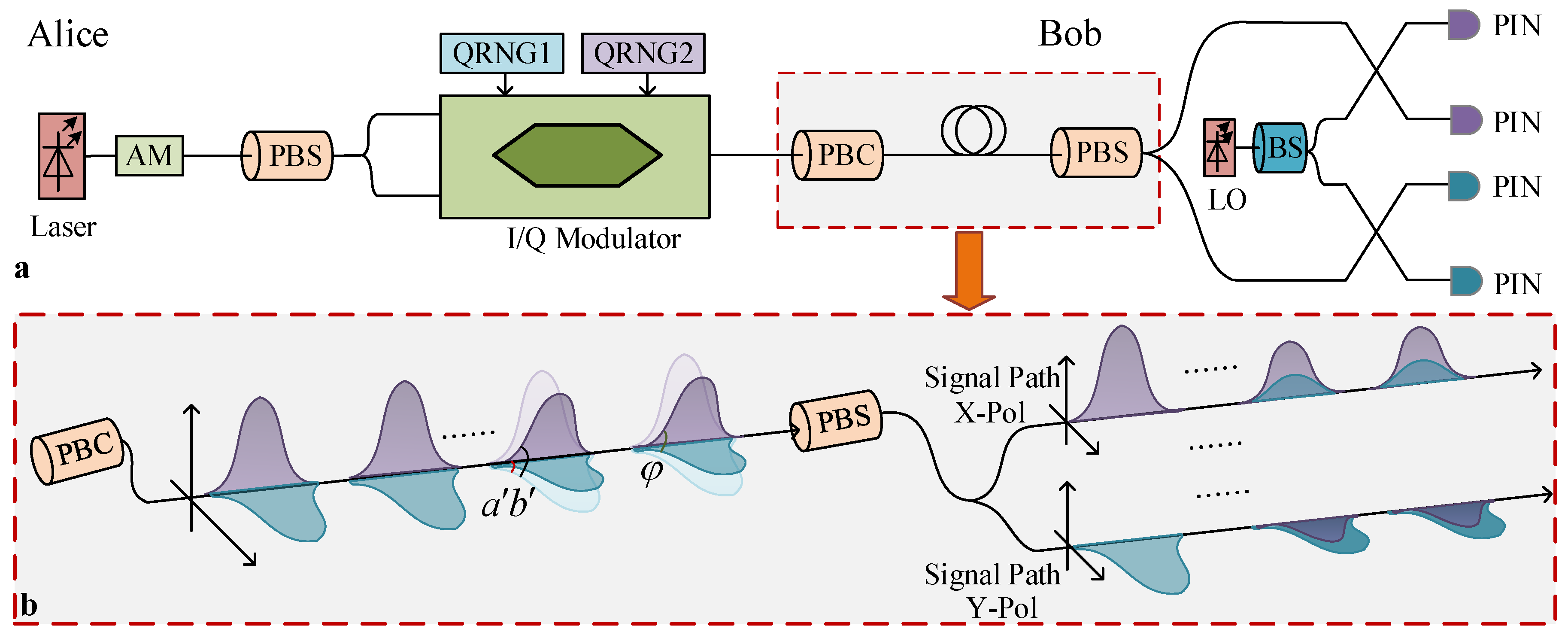

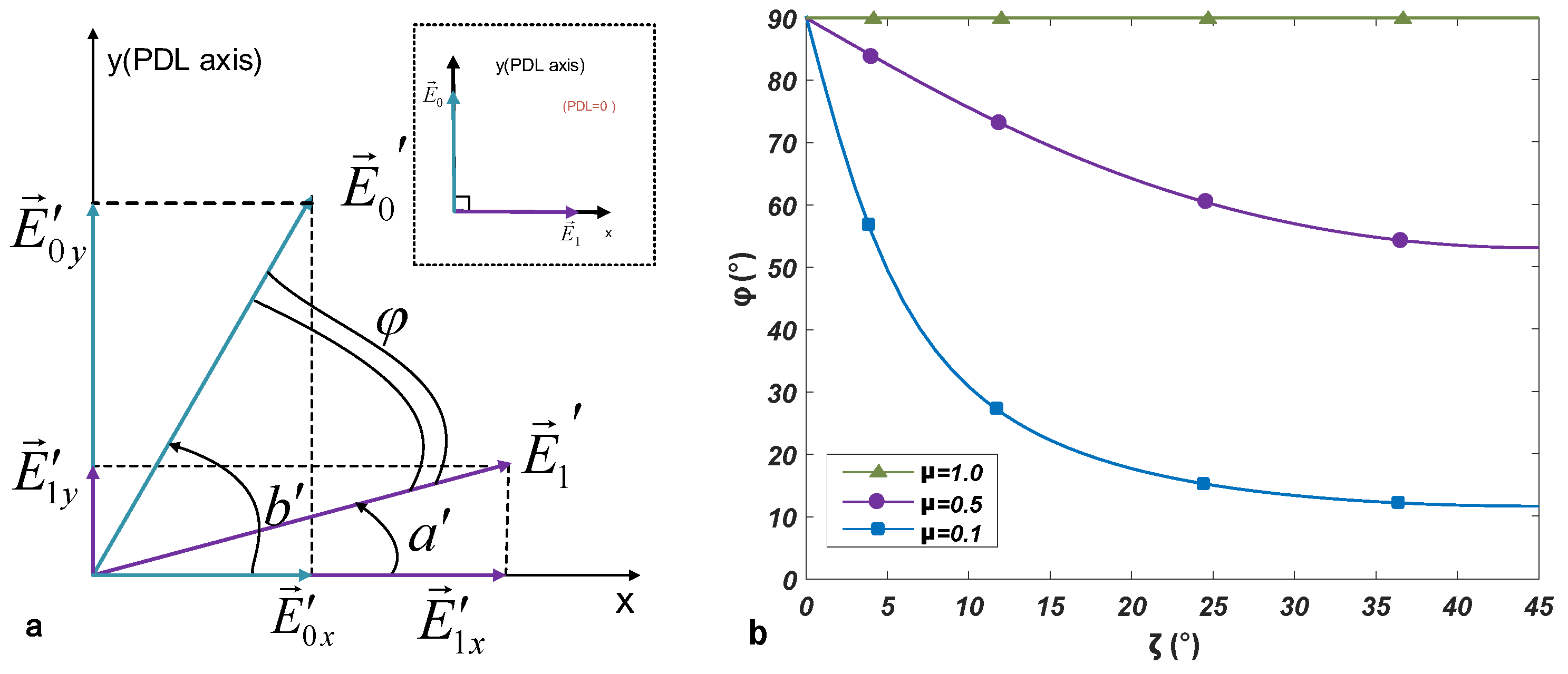
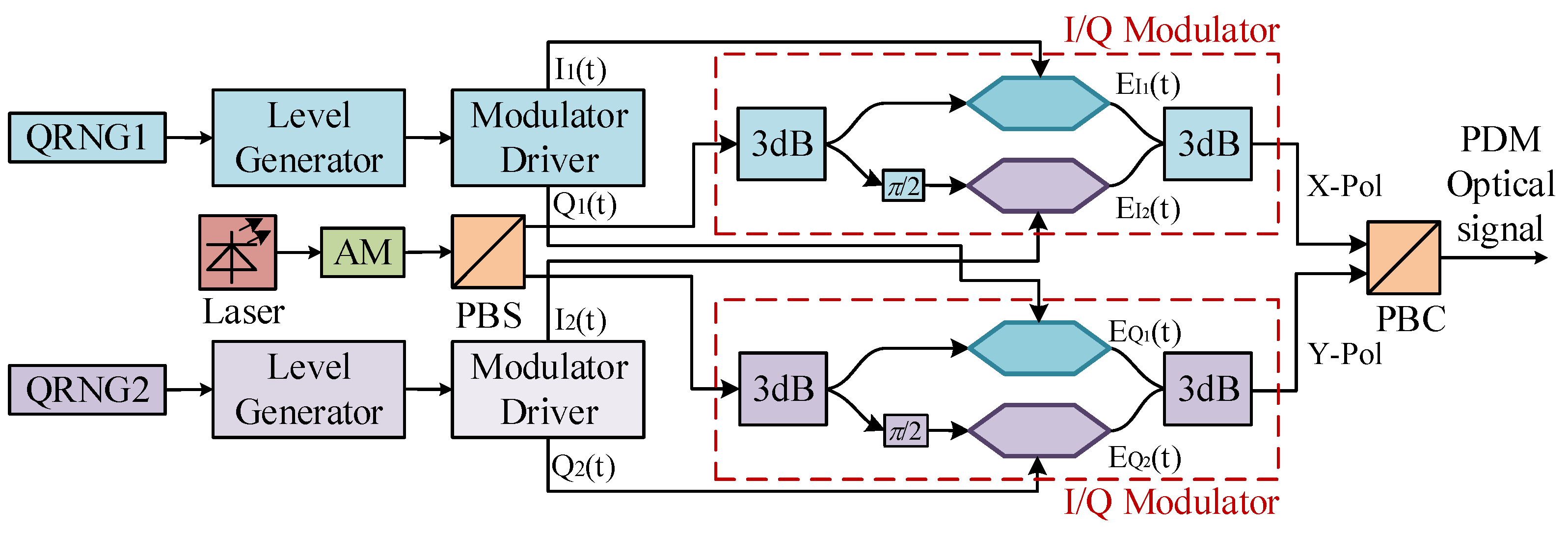
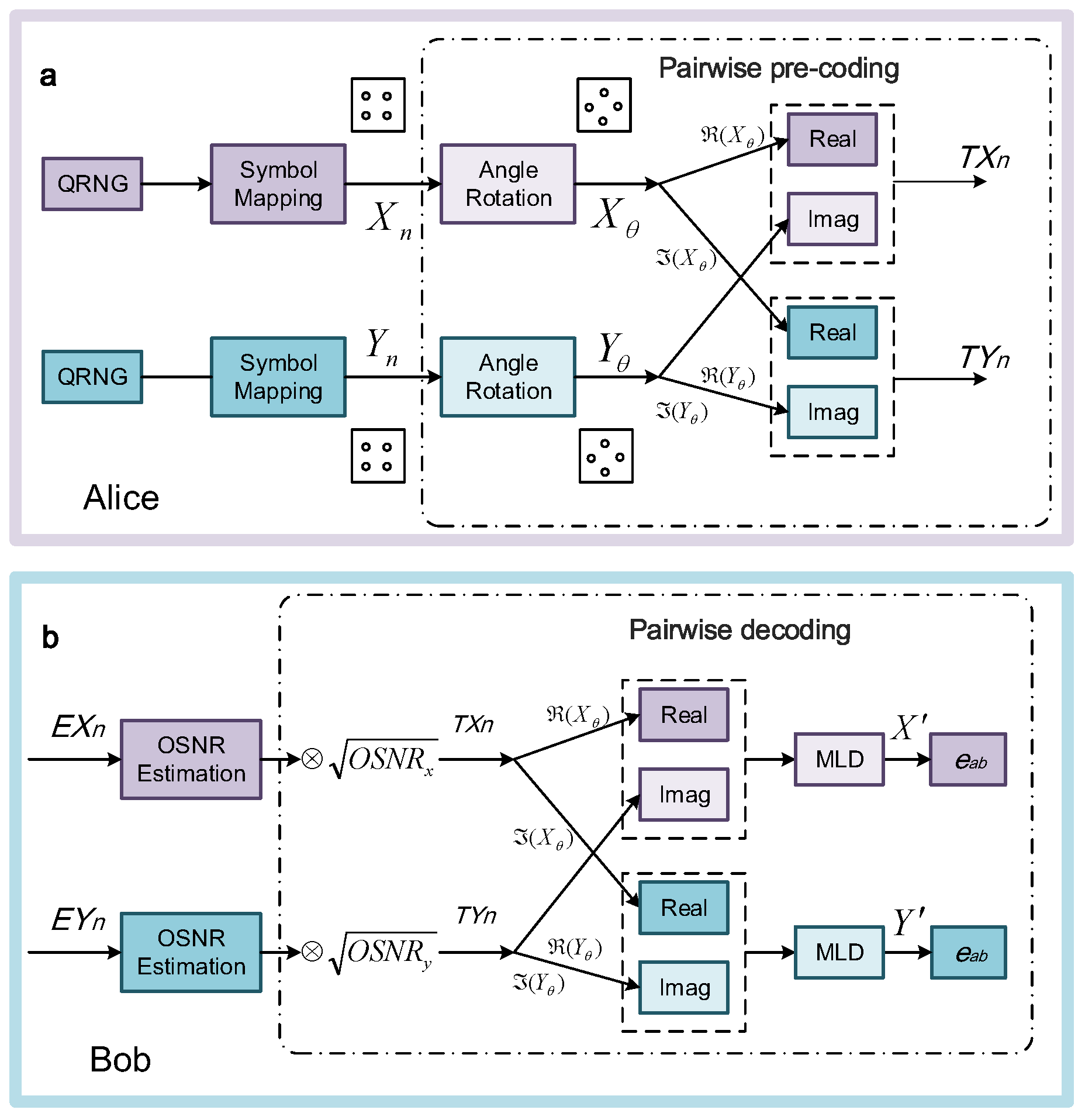
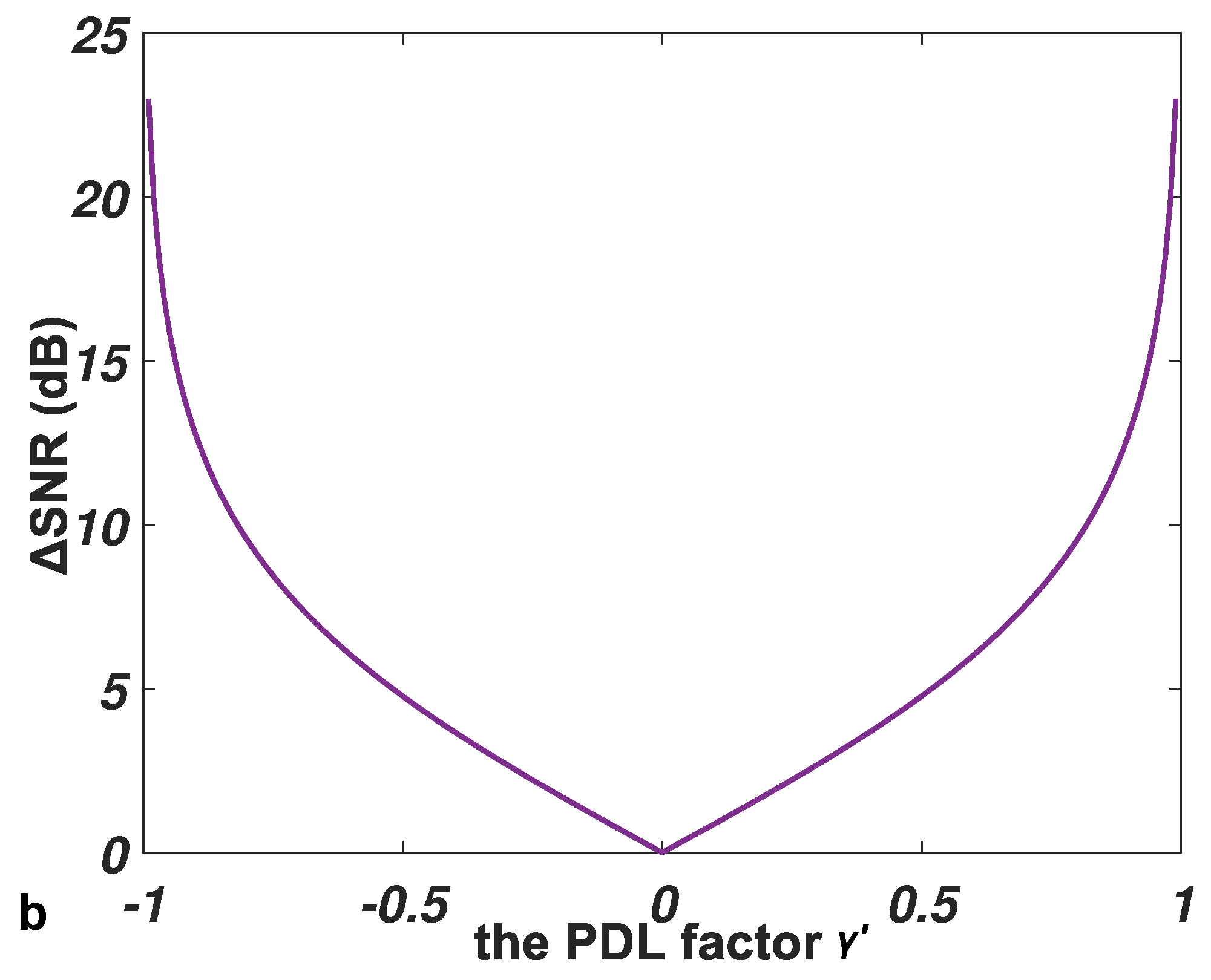
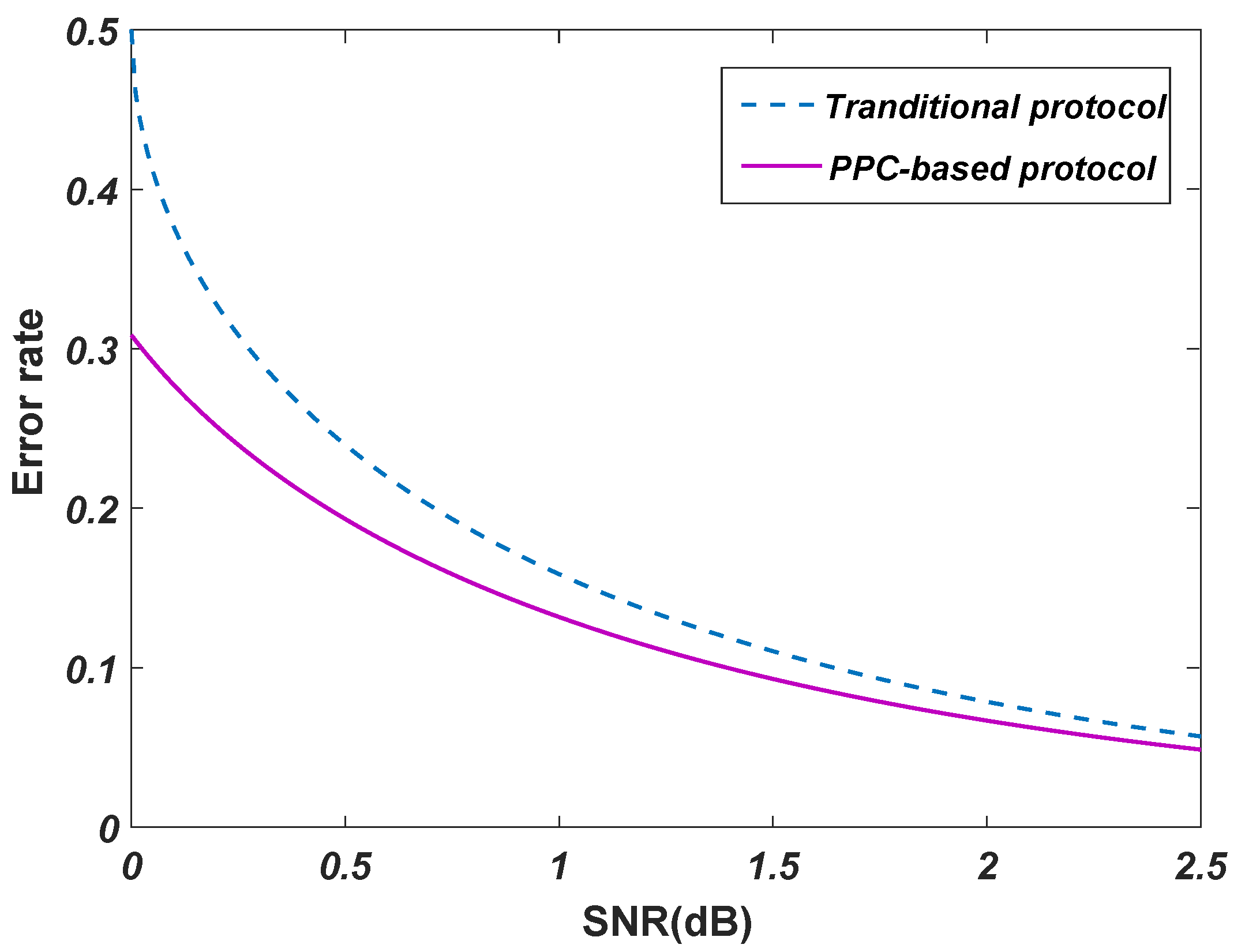
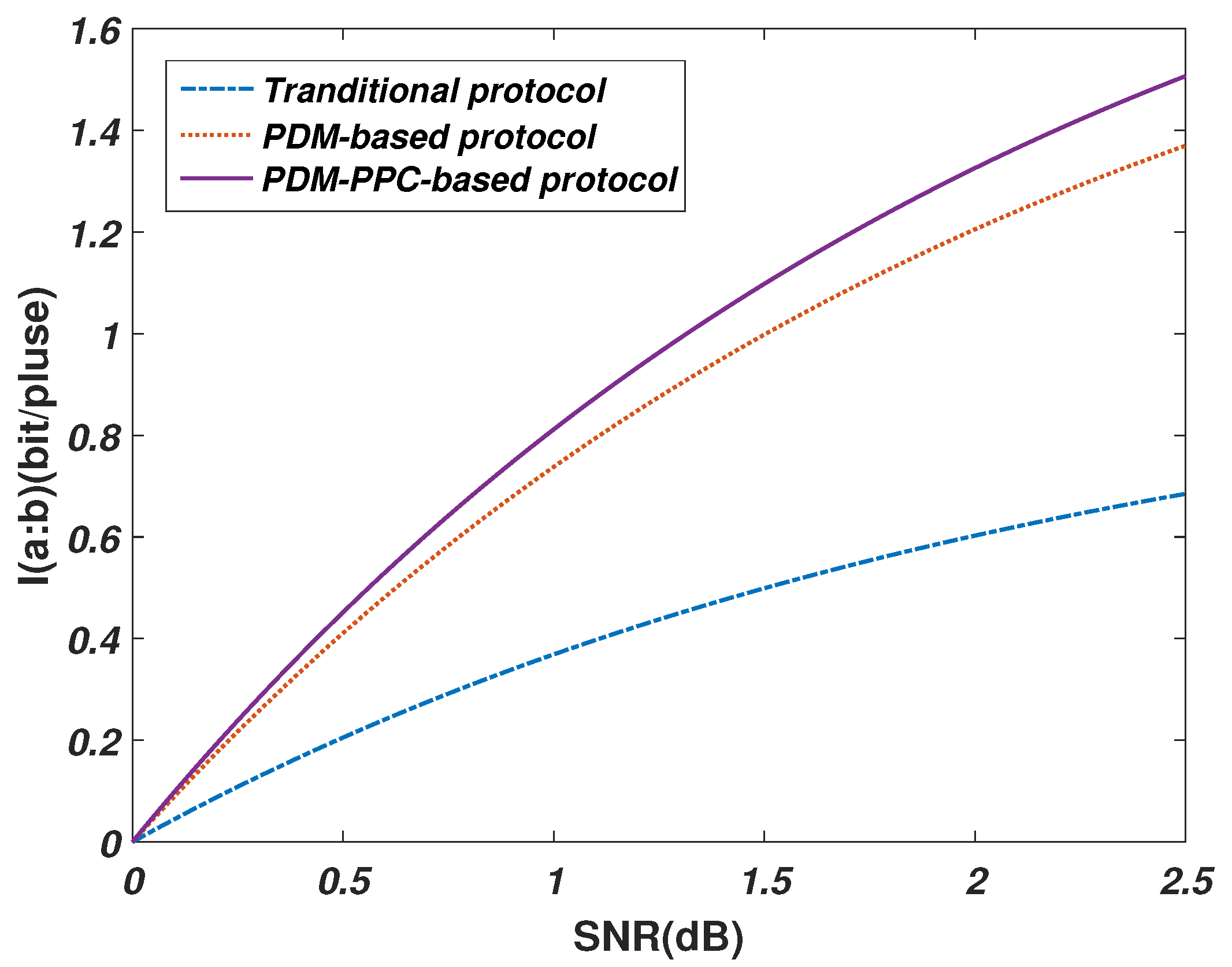

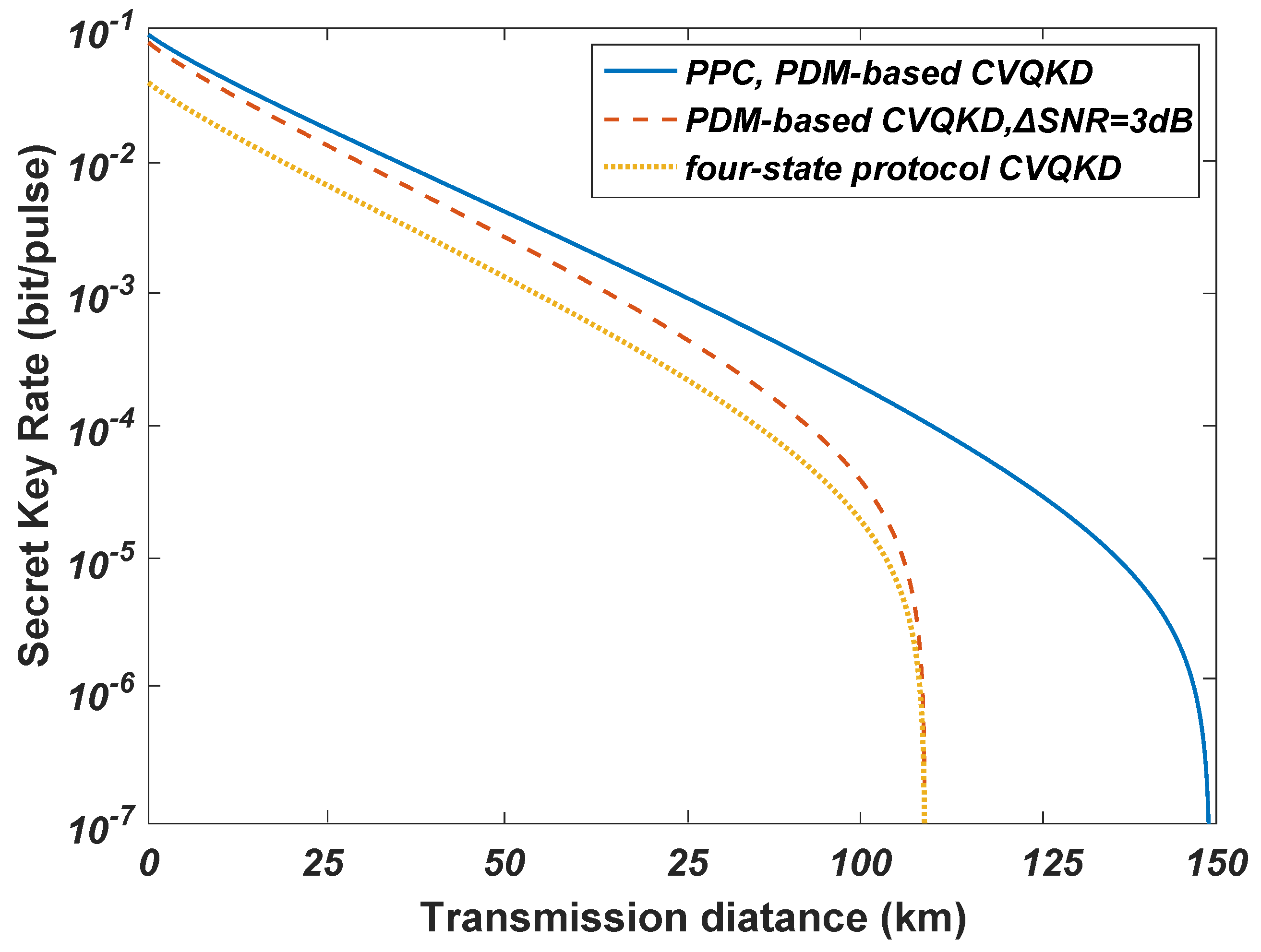
| Symbol | Meaning |
|---|---|
| the equivalent transmittance of quantum channel after PPC scheme | |
| the equivalent excess noise of quantum channel after PPC scheme | |
| the excess noise due to lack of orthogonality | |
| the error rate between Alice and Bob after coherent detection |
© 2019 by the authors. Licensee MDPI, Basel, Switzerland. This article is an open access article distributed under the terms and conditions of the Creative Commons Attribution (CC BY) license (http://creativecommons.org/licenses/by/4.0/).
Share and Cite
Guo, Y.; Cai, M.; Huang, D. Continuous-Variable Quantum Key Distribution Robust Against Polarization-Dependent Loss. Appl. Sci. 2019, 9, 3937. https://doi.org/10.3390/app9183937
Guo Y, Cai M, Huang D. Continuous-Variable Quantum Key Distribution Robust Against Polarization-Dependent Loss. Applied Sciences. 2019; 9(18):3937. https://doi.org/10.3390/app9183937
Chicago/Turabian StyleGuo, Ying, Minglu Cai, and Duan Huang. 2019. "Continuous-Variable Quantum Key Distribution Robust Against Polarization-Dependent Loss" Applied Sciences 9, no. 18: 3937. https://doi.org/10.3390/app9183937
APA StyleGuo, Y., Cai, M., & Huang, D. (2019). Continuous-Variable Quantum Key Distribution Robust Against Polarization-Dependent Loss. Applied Sciences, 9(18), 3937. https://doi.org/10.3390/app9183937






